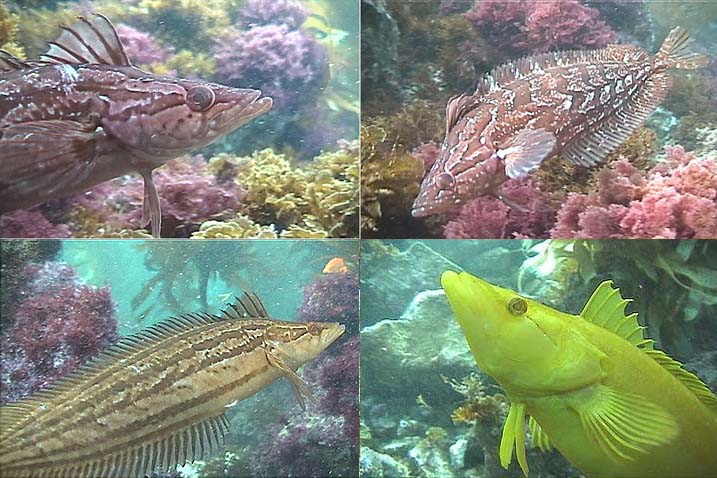

Some of my best dives have included giant kelpfish as dive "buddies." When there in a bit of surge in our shallower waters, these fish make great subjects for video as they move back and forth with the water. Since I am doing the same, it often looks as if these beautiful fish are dancing a ballet in the water. I have even had individuals follow me through the water for short distances and seem very curious about the truly "giant" fish in their midst.
This species is known from British Columbia to southern Baja California, but is most common from Point Conception south. One could hardly expect to find kelpfish in warmer tropical waters where coral rather than kelp forests dominate. Giant kelpfish are not really giant, just much larger than the other species of kelpfish in our area. Although one individual exceded two feet, fish larger than 15" are rare. At the end of a year these fish are already 6-7" long. They differ from the other kelpfish by having forked tails in addition to larger size.
These fish come in a variety of colors including brown, dark olive green, yellow green, yellow and red. Some have somewhat solid coloration while others have stripes or patterned bodies. UCSB fish specialist Dr. Milton Love states that giant kelpfish change colors with a varying degree of skill. Young kelpfish tend to be a solid light green but can change quickly to a brown color to blend in with their environment if need be. Females are able to change between all the color variants over time. Male kelpfish are far less capable and are unable to change to red or light green. Most likely the reason for this is the female's greater need to blend in with its environment to protect the eggs in its body. However, I'd expect the males to be a little better at camouflage since they defend the eggs.
Kelpfish are most frequently found in giant kelp, southern sea palm kelp and smaller attached red or brown algae. They are able to orient their bodies, which resemble kelp blades, to blend well with the algae. When threatened, they tend to duck into giant kelp or southern sea palm for cover. It is somewhat humorous to watch a red giant kelpfish, colored to be camouflaged against the red algae, duck into a southern sea palm where it contrasts and is very noticeable. Even though they adopt the same "posture" as the kelp blades, they are quite obvious. Of course the yellow or light green kelpfish, camouflaged in giant kelp or sea palm, looks equally funny when it swims into the red algae. I guess their fear confuses them a bit (what color am I today?).
This species feeds on small crustaceans including amphipods and shrimp as well as small fish. On many occasions I have observed giant kelpfish hunting in algae on the rocks or the bottom. They use their eyes to find their prey, observing the algae carefully before poking their long heads into thick mass. Once prey is located they lunge their bodies forwartd to capture it in their mouths. In turn they are eaten by cormorants and some other birds like terns. I was surprised to see a giant kelpfish chase a normally fearless adult garibaldi away when it approached. At first I thought this was a fluke since garibaldi are rarely threatened by other species including humans. However I have seen this behavior several times so it is not rare.
Giant kelpfish are reproductive at just over a year (7-8") and spawn throughout the year, peaking from January to May in island waters. The females lay 400-1,200 eggs in nests of algae. The eggs have threads which tangle in the algae and keep them in the nest. Males guard the eggs for the 12-17 days required for them to hatch. The hatched larvae drift in the plankton for about two weeks, allowing them to disperse a bit along the coast before they settle. I have observed these small kelpfish hidden amongst the algae, in crevices or under rocks in shallow waters. Their dancing will come a bit later in life. Hopefully they will prefer the ballet of their parents rather than some new generation crap, er I mean rap.
© 2003 Dr. Bill Bushing. Watch the "Dive Dry with Dr. Bill" underwater videos on Catalina Cable TV channel 49, 10:00 AM and 5:00 PM weekdays.

Image caption: Giant kelpfish in the kelp beds of Santa
Catalina Island
This document maintained by
Dr. Bill Bushing.
Material
© 2003 Star Thrower Educational Multimedia